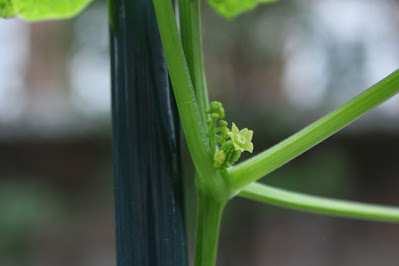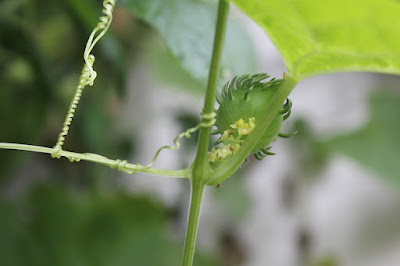Fat Babies, the nickname for this particular type of Achocha, are my star experimental plant in the veg patch and balcony this year. Admittedly, I muddled my seed order and thought I was buying eXplOding Fat Babies so I was quite bemused to find that my babies were quite docile, if alarmingly vigorous in their growth.
I met gardener and author Alex Mitchell earlier this year and, over a mug of coffee in my sitting room, she spied the spiky Achocha fruits poking out of the vine growing across my balcony. Having just written an inspirational book about Edible Balconies, she was intrigued by this plant as I'd created a sort of mini Forest Garden on my tiny balcony. (It towered over herbs, tomatoes, chilli peppers, spinach, radishes, orache, beans, nasturtiums and violets.) But more of my balcony food growing later ...
The seeds came from the Real Seed Company who describe the young fruits as tasting of sweet green peppers; personally, I find cooking them in butter reminds me of the taste of asparagus. (For me, this is good.) Other people have likened the taste to grass (less appealing), having taken to heart the advice that they can be chopped and eaten raw in salads. From my viewpoint, I'm just really pleased to be able to pick 'peppers' in December from the veg patch.
I met gardener and author Alex Mitchell earlier this year and, over a mug of coffee in my sitting room, she spied the spiky Achocha fruits poking out of the vine growing across my balcony. Having just written an inspirational book about Edible Balconies, she was intrigued by this plant as I'd created a sort of mini Forest Garden on my tiny balcony. (It towered over herbs, tomatoes, chilli peppers, spinach, radishes, orache, beans, nasturtiums and violets.) But more of my balcony food growing later ...
Given the vagaries of the weather this autumn, I'm uncertain if this late harvest is usual but the plants grown on the balcony have just about finished while the plants in the veg garden are still fruiting - I counted nearly 20 fruits ready to be picked. I'm guessing that this is because the balcony plants had only a small window box to grow in and only saw the sun in the afternoon whereas the veg patch achocha had lots more sun and open space. Nevertheless, the vines grew up and across the pigeon netting, easily reaching 10 feet long from one spindly, seemingly dead stem.They put out long tendrils, rather like peas, that reach out for anything to grab and wrap around.
And, having found an anchor, form very strong spiral springs to keep their grip! An awesome protection system which has seen my Fat Babies sail through stormy weather this year.
I had two of these plants growing on the balcony and the vines filtered the sun beautifully all summer. Down in the veg patch, one solitary plant clambered around a 9 foot high cane wigwam and then got all tangled up as the vines had nowhere else to go. The vines can reach over 16 feet long! Real Seeds recommend that these should not be grown in a polytunnel as they can apparently completely take over, which I can easily believe. I think the plants would look lovely growing over a big wooden arch, like a grapevine, but they're an annual so die back in winter.
Achocha hails from South America, its Latin name is Cyclanthera brachystacha and, although it likes a nice sunny spot to grow in, it will happily thrive in the UK as long as the soil is free draining and kept moist. There are a few variants but Fat Baby have bright green flesh with soft spines and, if allowed to mature, large black jagged edged seeds which look like small flat beetles.
The fruits can be eaten at any size, small (about an inch) or large (up to 3 inches). The larger ones have to be split open and the seeds removed before being cooked. If the spines have started to go brown, I just rub them off. They tend to fall off anyway when the fruit is being sliced.
I've added them to vegetable chillies and eaten them fried with mushrooms but they can be sliced into a salad or onto a pizza, particularly when small. I think they would also be very nice in a stir fry with noodles. In any recipe that calls for a green pepper, you can reach for several of these instead. The flesh is thinner than a supermarket green pepper (so less watery), the taste greener and less sweet. Because they're very small, you need quite a lot to cook with, probably at least 10 to replace one green bell pepper. But these are much more fun to look at.
The original seeds supplied are non-hybrid (ie, will grow again true to the original plant) and the Real Seed Company encourage future seed saving of all their seeds. Achocha seeds are very easy to collect because of their size so, come next April when we're all starting over, if anyone would like to try Achocha, I think I might just have a few spare.









